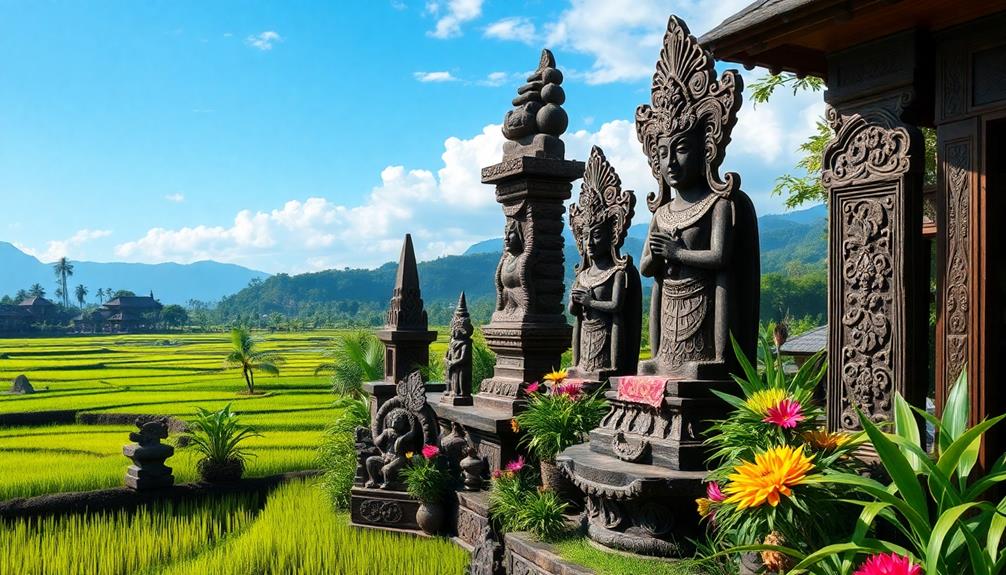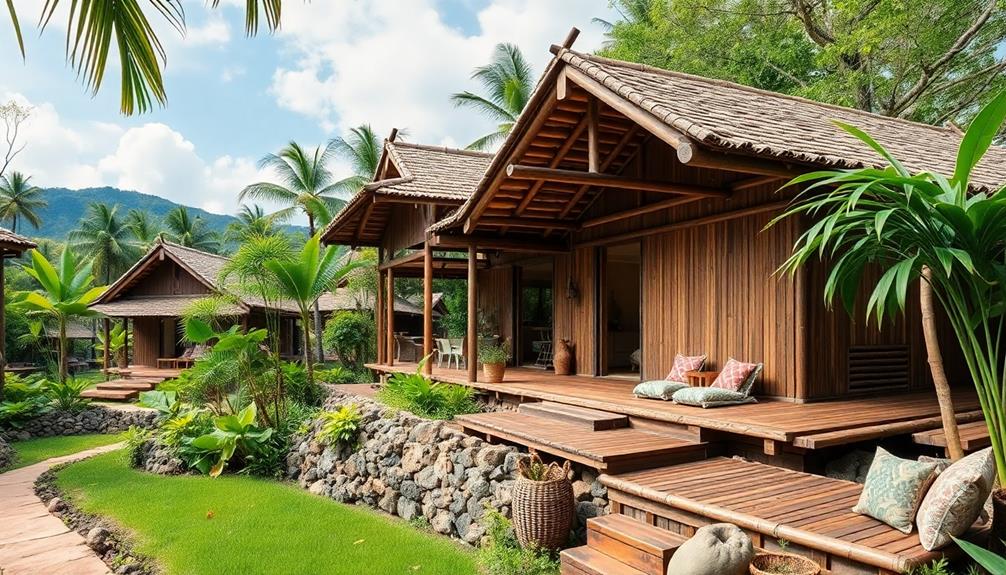Balinese design motifs embody a deep spiritual connection between life and the afterlife. Each symbol, like the Barong for protection or floral patterns for beauty, conveys rich meanings tied to Hindu beliefs. Geometric shapes illustrate life's cycles, while colors offer additional layers of symbolism. For instance, white signifies purity, and black represents balance between existence and the afterlife. You'll find these motifs in textiles, jewelry, and home decor, intertwining cultural heritage with everyday life. If you're curious about how these motifs influence Balinese culture, you'll uncover even more fascinating details soon.
Key Takeaways
- Balinese design motifs reflect a deep connection between physical existence and spiritual beliefs, emphasizing harmony in life and the afterlife.
- Floral patterns symbolize beauty and nature's transience, while the Barong motif represents protection and good fortune from evil spirits.
- Geometric designs illustrate the cycle of life and embody key Hindu philosophical concepts, enriching the cultural narrative.
- Colors used in motifs carry specific meanings, such as white for purity, yellow for divinity, and black for balance between life and afterlife.
- Traditional techniques like batik dyeing preserve cultural heritage, with intricate designs narrating stories from Balinese mythology and spiritual significance.
Significance of Balinese Spiritual Symbols

Balinese spiritual symbols play an essential role in the island's rich cultural tapestry, reflecting a deep connection between the physical and spiritual domains. These symbols are deeply rooted in Hindu beliefs, embodying the harmony between life and the afterlife.
Additionally, many Balinese artisans incorporate traditional motifs into their crafts, such as the vibrant designs found in Indonesian decor masks, which serve as a representation of their cultural heritage. By understanding these symbols, you gain insight into their cultural significance, as they often represent concepts like protection and good fortune.
For instance, the Barong symbolizes protection against evil spirits, while floral patterns, such as the frangipani, highlight the beauty and transient nature of existence. Geometric patterns, on the other hand, signify the cycle of life and the divine trinity, reminding you of the spiritual philosophies that underline Balinese culture.
The colors used in these motifs also carry weighty meanings; white represents purity, yellow signifies divinity, and black illustrates the balance between life and the afterlife.
Additionally, the use of symbolic scripts in clothing adds another layer of meaning, offering blessings and protection to the wearer. By delving into these spiritual symbols, you not only appreciate their beauty but also connect with the profound beliefs that shape Balinese life.
Common Motifs and Their Interpretations
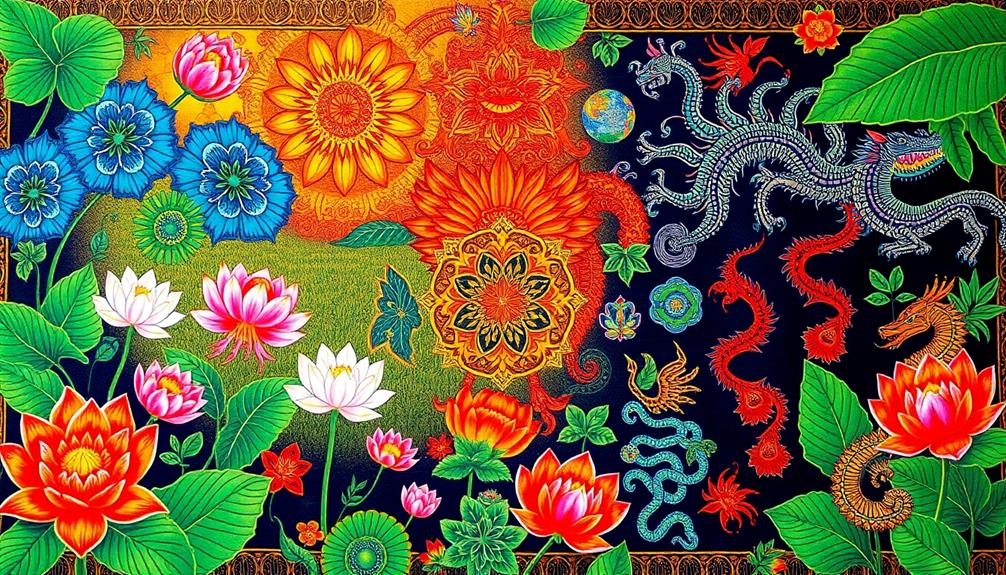
In exploring the rich tapestry of design, you'll encounter common motifs that reveal deep cultural meanings in Balinese art. Floral patterns, like the frangipani, symbolize beauty and the transience of life, reflecting the profound connection to nature that permeates Balinese culture. These motifs aren't only decorative but also serve to enhance the overall aesthetic of Balinese interior design concepts.
You'll also find the Barong motif, which represents protection and good fortune, often showcased in textiles and jewelry. This motif embodies the spirit of victory over evil forces, reinforcing a sense of security.
Geometric patterns play a significant role too, signifying the cycle of life and the divine trinity, illustrating key philosophical concepts central to Hindu beliefs. As you examine the designs, notice the symbolic scripts, including ancient alphabets, woven in as blessings and protective charms, which enrich the artwork's cultural narrative.
Additionally, the black and white chequered cloth known as Kain Poleng represents the duality of existence, balancing yin and yang, light and dark. This motif is commonly used in various ceremonial contexts, emphasizing the spiritual connection that Balinese design fosters.
Each element you encounter invites you to explore deeper into the cultural nuances that shape this vibrant art form.
The Role of Color in Symbolism

Colors play an essential role in expressing the rich symbolism found in Balinese culture. Each hue carries significant meaning, contributing to the visual storytelling woven into garments and rituals.
For instance, vibrant colors are often showcased in Indonesian Decorative Pillows, enhancing living spaces while reflecting cultural heritage.
Here are some key colors and their symbolism:
- White: Represents purity and divine presence, often used in ceremonial garments to reflect spiritual significance.
- Yellow: Associated with the gods, yellow is common in offerings and religious attire, symbolizing enlightenment and divine connection.
- Black: Darker shades, particularly black, are reserved for significant life events like funerals, symbolizing the end of life and the journey to the afterlife.
- Red: Bright and bold, red signifies strength and courage, frequently incorporated into traditional attire to convey liveliness and protection.
Through the careful selection of these colors, Balinese design narrates a philosophy of balance and harmony.
It reflects the interplay between light and darkness, good and evil, reminding you of the importance of living in equilibrium.
Understanding these colors enables you to appreciate the deeper layers of meaning embedded in Balinese design motifs.
Materials and Techniques in Design
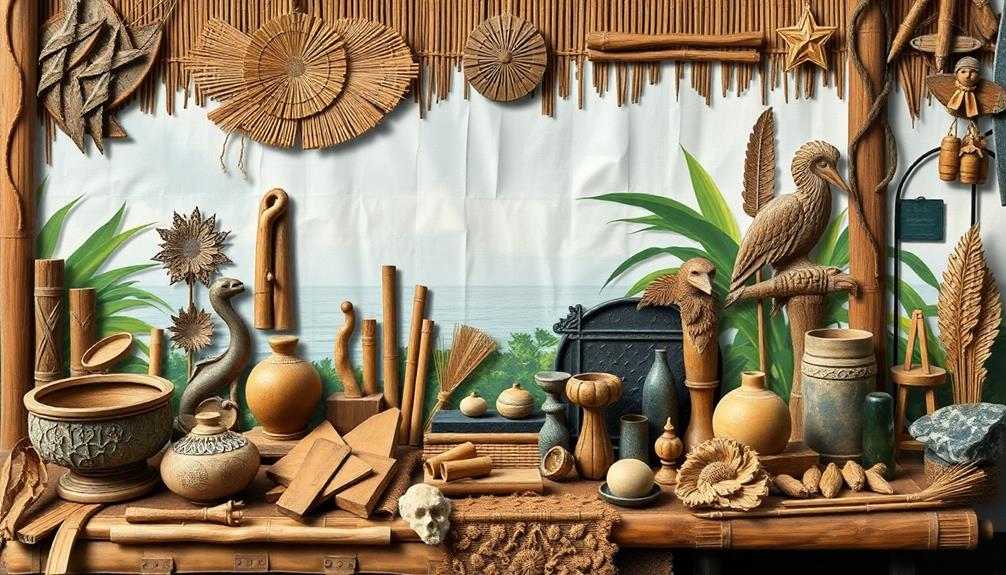
A variety of materials and techniques come together to create the stunning designs found in Balinese textiles. You'll notice that artisans mainly use natural fibers like cotton and silk, with cotton being lightweight for everyday wear and silk reserved for formal garments due to its luxurious texture.
Traditional artistry is evident as handwoven fabrics play a crucial role, often narrating stories from Balinese mythology through intricate designs.
Natural dyes sourced from plants, roots, and insects bring vibrant colors to life, each hue carrying a spiritual message—white symbolizes purity, while yellow represents divine presence. The batik dyeing technique is particularly significant, illustrating scenes from Hindu epics and preserving cultural heritage through exquisite textile art.
Craftsmanship shines in Balinese design, characterized by detailed motifs and high-relief techniques. These artisans dedicate themselves to storytelling through their work, ensuring that each piece isn't just a fabric, but a canvas of cultural expression.
Utilizing bamboo poles for structure, they create stunning textiles that resonate with the community's identity. In every thread, you can sense the love and tradition that go into making these remarkable designs.
Incorporating Motifs Into Daily Life
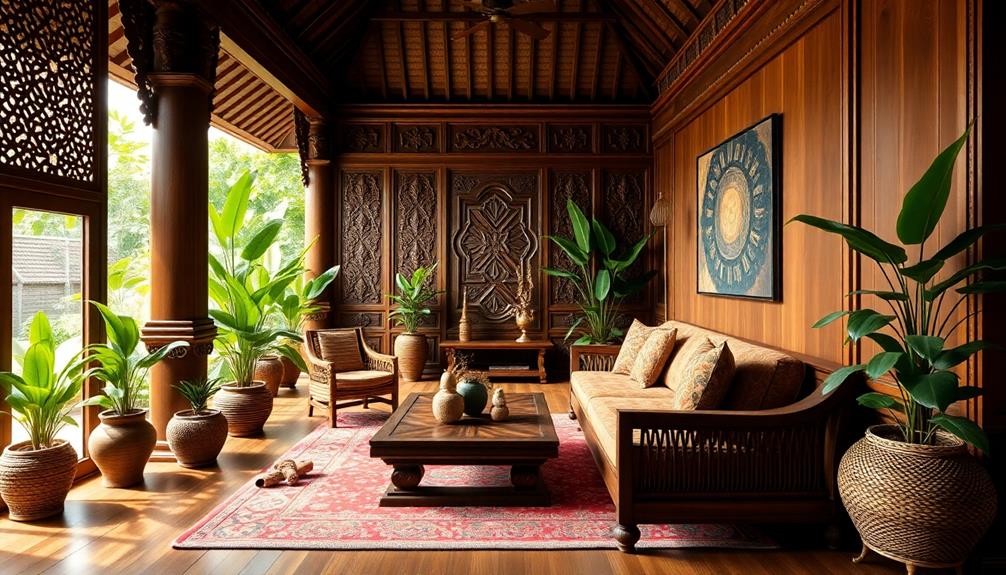
Incorporating Balinese motifs into your daily life can be a beautiful way to celebrate and honor this rich cultural heritage. By integrating these traditional designs, you can create a sense of harmony and tranquility in your surroundings while supporting local artisans and appreciating the importance of Indonesian decor masks.
Here are some easy ways to incorporate Balinese motifs:
- Wear Traditional Clothing: Adorn yourself with sarongs and kebayas that showcase meaningful patterns reflecting cultural and spiritual beliefs.
- Choose Symbolic Jewelry: Opt for pieces featuring designs like the Barong for protection or the Om Kara for harmony, adding cultural significance to your outfits.
- Enhance Home Decor: Use batik textiles or carved wooden sculptures in your living space to evoke the balance and beauty central to Balinese philosophy.
- Select Everyday Accessories: Incorporate bags or footwear with Balinese motifs to subtly express your appreciation for this vibrant culture while promoting artisanship.
Frequently Asked Questions
What Is the Balinese Design Element?
Balinese design elements showcase intricate motifs, vibrant colors, and natural materials. You'll notice floral patterns, geometric shapes, and symbolic scripts that all reflect the rich cultural heritage and spiritual significance integral to Bali's artistic expression.
What Is the Balinese Design Philosophy?
You'll find that Balinese design philosophy emphasizes harmony among humans, nature, and the divine. It guides how spaces are created, ensuring they foster balance, peace, and spiritual connection within the environment and architectural elements.
What Does the Balinese Hinduism Symbol Mean?
You might think the swastika's just a symbol, but in Balinese Hinduism, it represents good fortune and protection. It embodies the island's spiritual essence, reminding you of the balance between light and darkness in life.
What Are the Principles of Balinese Architecture?
In Balinese architecture, you'll notice principles like Tri Hata Karana, which fosters harmony; Tri Mandala, which organizes sacred spaces; and Asta Kosala Kosali, guiding placement for spiritual significance, all reflecting deep cultural values and beliefs.
Conclusion
So, next time you admire Balinese design, remember it's not just pretty patterns; it's a vibrant tapestry of spirituality and culture. Who knew that those beautiful motifs were more than just a Pinterest board dream? Embrace the colors and symbols in your daily life, and maybe, just maybe, you'll elevate your home from "meh" to "magical." After all, nothing says "I've got my life together" like a little spiritual symbolism on your coffee mug!
